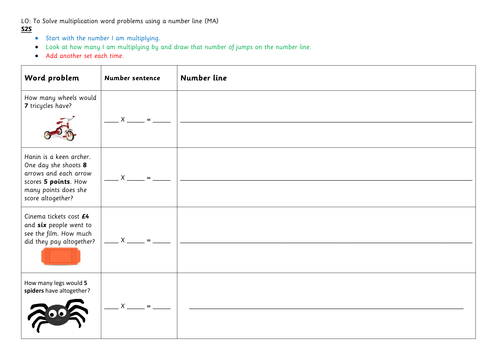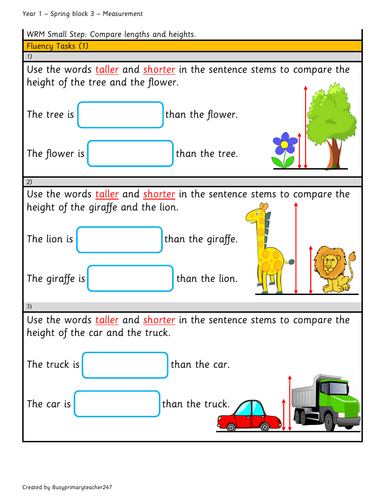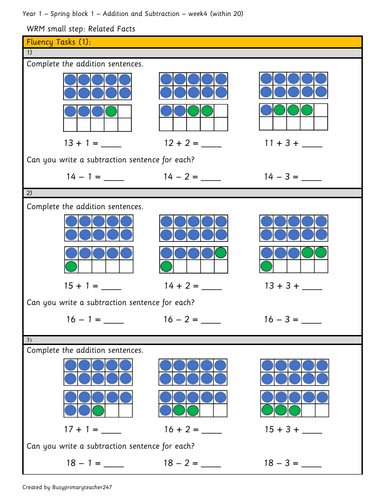132Uploads
174k+Views
66k+Downloads
Mathematics

Yr 3 Number: Dividing by 3
Year 3 Number: Multiplication & Division – Dividing by 3 Varied Fluency & Reasoning.
This resource is differentiated 3 ways and follows the concrete-pictorial-abstract method of Maths Mastery. The worksheets explore dividing by 3 through sharing into three groups and grouping in threes.
Links to National Curriculum:
Count from 0 in multiples of 4, 8, 50 and 100.
Recall and use multiplication and division facts for the 3, 4 and 8 multiplication tables.
Write and calculate mathematical statements for multiplication and division using the multiplication tables they know, including for two-digit numbers times one-digit numbers, using mental and progressing to formal written methods.
Solve problems, including missing number problems, involving multiplication and division, including positive integer scaling problems and correspondence problems in which n objects are connected to m objects.
Pictures used in this resource have been created by Busyprimaryteacher247
Other images sourced from - https://wpclipart.com

Year 3 - Using a number line to solve multiplication word problems - Differentiated
Year 3 - Using a number line to solve multiplication word problems - Differentiated BA, MA, HA
Enjoy! Your feedback is always welcome x

Fractions - Calculating Quantities - Quiz Card Cooperative Activity
This is a fun and active way to get your class reviewing and consolidating their understanding of calculating quantities. Great as a lesson warm up, end of lesson plenary or test prep. Children work co-operatively with different partners to quiz each other on a variety of questions. If a child gets a question wrong, they give clues and ‘tutor’ them, so that they can both be successful. This product includes 36 quiz cards plus a blank template for children to make their own!
Enjoy!
You freedback is always welcome x

Year 1 - Place Value - Counting One More 0-10
This resource follows the mastery approach to Year 1 place value (concrete - pictorial - abstract) with a main focus on counting one more from any given number 0-10
Resources included in this pack:
Power point presentation
Working wall display items
Student worksheets differentiated lower ability, age related, greater depth (including answers)
Reasoning and problem solving
Curriculum Links:
UK:
Count, read and write numbers to 10in numerals and words.
Given a number, identify one more or one less.
Identify and represent numbers using objects and pictorial representations including the number line, and use the language of: equal to, more than, less than (fewer), most, least.
Australia:
ACMNA013 - Modelling numbers with a range of material and images
ACMNA002 - Connect number names, numerals and quantities, including zero, initially up to 10 and then beyond
ACMNA289 - Compare, order and make correspondences between collections, initially to 20, and explain reasoning
American Common Core Standards
CCSS.MATH.CONTENT.K.CC.A.3
Write numbers from 0 to 20. Represent a number of objects with a written numeral 0-20 (with 0 representing a count of no objects).
CCSS.MATH.CONTENT.K.CC.B.4.A
When counting objects, say the number names in the standard order, pairing each object with one and only one number name and each number name with one and only one object.
CCSS.MATH.CONTENT.K.CC.B.4.C
Understand that each successive number name refers to a quantity that is one larger.

Year 1 - Place Value - Count One Less 0-10
This resource follows the mastery approach to Year 1 place value (concrete - pictorial - abstract) with a main focus on finding one less from any given number 0 - 10.
Resources included in this pack:
Power point presentation
Working wall display items
Student worksheets differentiated lower ability, age related, greater depth (including answers)
Reasoning and problem solving
Co-operative Learning game: I have, Who has (Whole class activity - warm up/plenary)
Curriculum Links:
UK:
Count, read and write numbers to 10 in numerals and words.
Given a number, identify one more or one less.
Identify and represent numbers using objects and pictorial representations including the number line, and use the language of: equal to, more than, less than (fewer), most, least.
Australia:
ACMNA013 - Modelling numbers with a range of material and images
ACMNA002 - Connect number names, numerals and quantities, including zero, initially up to 10 and then beyond
ACMNA289 - Compare, order and make correspondences between collections, initially to 20, and explain reasoning
American Common Core Standards
CCSS.MATH.CONTENT.K.CC.A.3
Write numbers from 0 to 20. Represent a number of objects with a written numeral 0-20 (with 0 representing a count of no objects).
CCSS.MATH.CONTENT.K.CC.B.4.A
When counting objects, say the number names in the standard order, pairing each object with one and only one number name and each number name with one and only one object.
CCSS.MATH.CONTENT.K.CC.B.4.C
Understand that each successive number name refers to a quantity that is one larger.

Year 1 - Place Value - Count Forwards From 0-10
This resource follows the mastery approach to Year 1 place value (concrete - pictorial - abstract) with a main focus on counting forwards from any given number 0-10.
Resources included in this pack:
Power point presentations
Working wall display items
Student worksheets differentiated lower ability, age related, greater depth (plus answers)
Reasoning and problem solving
Curriculum Links:
UK:
Count, read and write numbers to 10 in numerals and words.
Given a number, identify one more or one less.
Identify and represent numbers using objects and pictorial representations including the number line, and use the language of: equal to, more than, less than (fewer), most, least.
Australia:
ACMNA013 - modelling numbers with a range of material and images
ACMNA002 - Connect number names, numerals and quantities, including zero, initially up to 10 and then beyond
ACMNA289 - Compare, order and make correspondences between collections, initially to 20, and explain reasoning
American Common Core Standards
CCSS.MATH.CONTENT.K.CC.A.3
Write numbers from 0 to 20. Represent a number of objects with a written numeral 0-20 (with 0 representing a count of no objects).
CCSS.MATH.CONTENT.K.CC.B.4.A
When counting objects, say the number names in the standard order, pairing each object with one and only one number name and each number name with one and only one object.
CCSS.MATH.CONTENT.K.CC.B.4.C
Understand that each successive number name refers to a quantity that is one larger.

Yr 3 Number: Multiplying by 3
Year 3 Number: Multiplication & Division – Multiplying by 3 Varied Fluency & Reasoning.
This resource is differentiated 3 ways and follows the concrete-pictorial-abstract method of Maths Mastery. The worksheets draw on knowledge of counting in threes in order to start to multiply by 3, and encourages children to use their knowledge of equal groups through using concrete and pictorial methods to solve multiplication problems.
Links to National Curriculum:
Count from 0 in multiples of 4, 8, 50 and 100.
Recall and use multiplication and division facts for the 3, 4 and 8 multiplication tables.
Write and calculate mathematical statements for multiplication and division using the multiplication tables they know, including for two-digit numbers times one-digit numbers, using mental and progressing to formal written methods.
Solve problems, including missing number problems, involving multiplication and division, including positive integer scaling problems and correspondence problems in which n objects are connected to m objects.
Pictures used in this resource have been created by Busyprimaryteacher247
Other images sourced from - https://wpclipart.com

Year 1 Measurement comparing length and height (week 8)
These resources suppot WRM Spring block 3 Measurement Small Step: Compare length and height.
Curriculum links
Compare, describe and solve ractical problems for:
lengths and heights (for example, long/short, longer/shorter, tall/short, double/half)

Year 4 – Fractions – Calculating Quantities – Spring Block
This resource includes varied fluency questions that focus on calculating fractions of quantities. It follows a concrete – pictorial – abstract approach for mastery and includes opportunities to use bar modeling and concrete materials. It also includes reasoning and problem-solving questions. Differentiated two ways and includes answers.
WRM Small Steps: Calculating Quantities
National Curriculum Links
• Recognise and show, using diagrams, families of common equivalent fractions.
• Count up and down in hundredths; recognise that hundredths arise when dividing an object by one hundred and dividing tenths by ten.
• Solve problems involving increasingly harder fractions to calculate quantities, and fractions to divide quantities, including non-unit fractions where the answer is a whole number.
• Add and subtract fractions with the same denominator.
Your feedback is always welcome x

Year 4 – Calculate Fractions of a Quantity – Spring Block 3 - Fractions
This resource includes varied fluency questions focusing on finding fractions of a quantity. It follows a concrete – pictorial – abstract approach for mastery and includes opportunities to use bar modelling. It also includes reasoning and problem solving questions. Differentiated two ways and includes answers.
WRM Small Steps: Calculate fractions of a quantity
National Curriculum Links
• Recognise and show, using diagrams, families of common equivalent fractions.
• Count up and down in hundredths; recognise that hundredths arise when dividing an object by one hundred and dividing tenths by ten.
• Solve problems involving increasingly harder fractions to calculate quantities, and fractions to divide quantities, including non-unit fractions where the answer is a whole number.
• Add and subtract fractions with the same denominator.

Year 1 - Addition and Subtraction (within 20) - block 1 - Spring (week 1)
These resources cover Year 1 - Addition and Subtraction (within 20) - block 1 - Spring (week 1).
They follow the CPA approach to mastery and link to the first two WRM small steps: 'Add by counting on' and 'Find and make number bonds'.
National Curriculum links:
- Represent and use number bonds and related subtraction facts within
20
- Read, write and interpret mathematical statements involving addition (+), subtraction (-) and equals (=) signs.
- Add and subtract one-digit and two-digit numbers to 20, including zero.
- Solve one-step problems that involve addition and subtraction, using concrete objects and pictorial representations, and missing number problems such as 7= ꙱ –9
Enjoy!
Your feedback is always welcome x

Year 1 - Spring block 1 - Addition & Subtraction (Within 20) - week 2
These resources cover Year 1 - Addition and Subtraction (within 20) - block 1 - Spring (week 2).
They follow the CPA approach to mastery and link to the first two WRM small steps: 'Add by making 10' and 'Subtraction – Not crossing 10'.
National Curriculum links:
- Represent and use number bonds and related subtraction facts within
20
- Read, write and interpret mathematical statements involving addition (+), subtraction (-) and equals (=) signs.
- Add and subtract one-digit and two-digit numbers to 20, including zero.
- Solve one-step problems that involve addition and subtraction, using concrete objects and pictorial representations, and missing number problems such as 7= ꙱ –9
Enjoy!
Your feedback is always welcome x
Images created by Busyprimaryteacher247
Other images sourced from: https://wpclipart.com/index.html

Year 3 - Question strips linked to WRM Spring block 1 - weeks 1-3
A handy set of resources that can be used as a warm-up task, extension tasks, formative and summative assessment. They also compliment the other packs of works sheets that are available in my shop.
They link directly to WRM Small steps:
Comparing statements
Related calculations
Multiply 2-digits by 1-digit (1)
Multiply 2-digits by 1-digit (2)
Divide 2-digits by 1-digit (1)
Divide 2-digits by 1-digit (2)
Divide 2-digits by 1-digit (3)
Scaling
How many ways?
Curriculum links:
-Recall and use multiplication and division facts for the 3, 4 and 8 multiplication tables.
-Write and calculate mathematical statements for multiplication and division using the multiplication tables they know, including for two-digit
numbers times one-digit numbers, using mental and progressing to formal written methods.
-Solve problems, including missing number problems, involving multiplication and division, including positive integer scaling problems and correspondence problems in which n objects are connected to m objects.
I hope you find these useful,
Your feedback is always welcome x

Year 3 - Spring Block 1 (week 3) Multiplication and Division
This set of resources follows the concrete-pictorial-abstract method of Maths Mastery. It contains fluency, reasoning, and problem-solving tasks.
The worksheets are differentiated between lower ability and age-related and the answers are included :)
Links directly to WRM small steps:
- Divide 2-digits by 1-digit (3)
-Scaling
-How many ways?
National curriculum links:
-Recall and use multiplication and division facts for the 3, 4 and 8 multiplication tables.
-Write and calculate mathematical statements for multiplication and division using the multiplication tables they know, including for two-digit numbers times one-digit numbers, using mental and progressing to formal written methods.
-Solve problems, including missing number problems, involving multiplication and division, including positive integer scaling problems and correspondence problems in which n objects are connected to m objectives.
I hope you find these resources helpful!
Your feedback is always welcome x

Year 1 - Spring block 1 - Addition and Subtraction within 20 (Week 4)
These resources follow the concrete-pictorial-abstract approach to Maths Mastery and also includes reasoning questions and answers.
Linked to small steps 'Related facts' and 'Compare number sentences' for week 4, Spring block 1.
Curriculum links:
-Represent and use number bonds and related subtraction facts within 20 -Read, write and interpret mathematical statements involving addition (+), subtraction (-) and equals (=) signs.
-Add and subtract one-digit and two-digit numbers to 20, including zero. -
Solve one-step problems that involve addition and subtraction, using concrete objects and pictorial representations, and missing number problems such as 7= ꙱–9
I hope you find this resource useful,
Your feedback is always welcome :)

Year 3 5-a-day maths activities Number and Place Value
The resources in this download covers Year 3 Place Value for weeks 1 to 3 of the autumn term. They support a mastery approach to teaching mathematics. Concrete-Pictorial-Abstract is promoted throughout.
All 15 tasks are designed as a 5-minute warm up activity at the beginning of Maths lessons.
Year 3 curriculum objectives covered are:
- Identify, represent and estimate numbers using different representations.
- Find 10 or 100 more or less than a given number.
- Recognise the place value of each digit in a three-digit number (hundreds, tens, ones).
- Compare and order numbers up to 1000.
- Read and write numbers up to 1000 in numerals and in words.
- Solve number problems and practical problems involving these ideas.
- Count from 0 in multiples of 50 and 100.
Enjoy! your feedback is always welcome x

Year 1 - Spring block 1 - Addition and Subtraction (within 20) week 3.
This resource covers Year 1 - Addition and Subtraction (within 20) - block 1 - Spring (week 3).
It follows the CPA approach to mastery and links to the WRM small steps: 'Subtraction crossing 10 (1)' and 'Subtraction crossing 10 (2)'
National Curriculum links:
- Represent and use number bonds and related subtraction facts within
20
- Read, write and interpret mathematical statements involving addition (+), subtraction (-) and equals (=) signs.
- Add and subtract one-digit and two-digit numbers to 20, including zero.
- Solve one-step problems that involve addition and subtraction, using concrete objects and pictorial representations, and missing number problems such as 7= ꙱ –9
Enjoy!
Your feedback is always welcome x

Statistics - Bar Charts (edited)
This resource contains varied fluency questions, reasoning and a challenge question. Differentiated 2 ways and includes answers. Linked to Year 3 Spring block 3. Statistics - WRM Small Step - bar charts.
Curriculum links
Interpret and present data using bar charts, pictograms and tables.
Solve one-step and two-step questions [for example, ‘How many more?’ and ‘How many fewer?’] using information presented
in scaled bar charts and pictograms and tables.

Statistics - Pictograms (edited)
This resource contains varied fluency questions, reasoning and a challenge question. Differentiated 2 ways. Linked to Year 3 Spring block 3. Statistics - WRM Small Step - Pictograms.
Curriculum links
Interpret and present data using bar charts, pictograms and tables.
Solve one-step and two-step questions [for example, ‘How many more?’ and ‘How many fewer?’] using information presented
in scaled bar charts and pictograms and tables.
Bundle

Year 3 Multiplication and Division Bundle Autumn term
This year 3 bundle contains 15 question strips related to multiplication and division for the Autumn term. Each strip follows the CPA approach for Maths Mastery and contain varied fluency and reasoning questions.




















